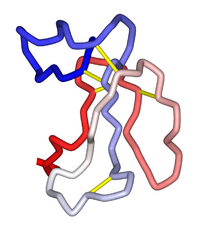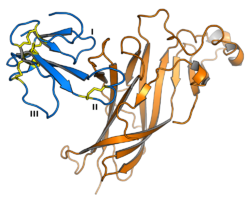Biology:Alpha-Bungarotoxin
| α-Bungarotoxin | |||||||
|---|---|---|---|---|---|---|---|
 | |||||||
| Identifiers | |||||||
| Organism | |||||||
| Symbol | N/A | ||||||
| CAS number | 11032-79-4 | ||||||
| UniProt | P60616 | ||||||
| |||||||
α-Bungarotoxin (α-BTX) is one of the bungarotoxins, components of the venom of the elapid Taiwanese banded krait snake (Bungarus multicinctus). It is a type of α-neurotoxin, a neurotoxic protein that is known to bind competitively and in a relatively irreversible manner to the nicotinic acetylcholine receptor found at the neuromuscular junction, causing paralysis, respiratory failure, and death in the victim.[2] It has also been shown to play an antagonistic role in the binding of the α7 nicotinic acetylcholine receptor in the brain, and as such has numerous applications in neuroscience research.
Structure
α-Bungarotoxin is a 74-amino-acid, 8 kDa α-neurotoxin with five disulfide bridges that binds as a competitive antagonist to nicotinic acetylcholine receptors (nAChRs). Like other snake venom α-neurotoxins, it is a member of the three-finger toxin protein family; its tertiary structure consists of a small globular core stabilized by four disulfide bonds, three projecting "finger" loops, and a C-terminal tail. The second loop contains an additional disulfide bond. The tips of fingers I and II form a mobile region that is essential for proper binding.[3]
Hydrogen bonds allow for an antiparallel β-sheet, which keeps the second and third loops roughly parallel. The three-finger structure is preserved by four of the disulfide bridges: the fifth can be reduced without loss to toxicity. The fifth bridge is located on the tip of the second loop.[4]
The multiple disulfide bonds and small amount of secondary structure seen in α-BTX is the cause of the extreme stability of this kind of neurotoxin. Since there are many entropically viable forms of the molecule, it does not denature easily, and has been shown to be resistant to boiling[5] and strong acids.[6][7]
Mechanism

α-neurotoxins antagonistically bind irreversibly to nAChRs of skeletal muscles, thereby blocking the action of ACh at the postsynaptic membrane, inhibiting ion flow and leading to paralysis. nAChRs contain two binding sites for snake venom neurotoxins.[9] The observation that a single molecule of the toxin suffices to inhibit channel opening is in agreement with experimental data on the amount of toxin per receptor.[10] Some computational studies of the mechanism of inhibition using normal mode dynamics[11] suggest that a twist-like motion caused by ACh binding may be responsible for pore opening, and that this motion is inhibited by toxin binding.[11][12]
Research applications
α-Bungarotoxin has played a large role in determining many of the structural details of the nicotinic acetylcholine receptors. It can be conjugated to a fluorophore or enzyme for immunohistochemical staining of fixed tissues and visualization via light or fluorescence microscopy. This application enables morphological characterization of the neuromuscular junctions.[13][14][15]
See also
References
- ↑ "The solution structure of the complex formed between alpha-bungarotoxin and an 18-mer cognate peptide derived from the alpha 1 subunit of the nicotinic acetylcholine receptor from Torpedo californica". The Journal of Biological Chemistry 276 (25): 22930–40. June 2001. doi:10.1074/jbc.M102300200. PMID 11312275.
- ↑ "Alpha-bungarotoxin binding to acetylcholine receptor membranes studied by low angle X-ray diffraction". Biophysical Journal 85 (2): 943–53. August 2003. doi:10.1016/s0006-3495(03)74533-0. PMID 12885641. Bibcode: 2003BpJ....85..943Y.
- ↑ "NMR structural analysis of alpha-bungarotoxin and its complex with the principal alpha-neurotoxin-binding sequence on the alpha 7 subunit of a neuronal nicotinic acetylcholine receptor". The Journal of Biological Chemistry 277 (14): 12406–17. April 2002. doi:10.1074/jbc.M110320200. PMID 11790782.
- ↑ "The crystal structure of alpha-bungarotoxin at 2.5 A resolution: relation to solution structure and binding to acetylcholine receptor". Protein Engineering 1 (1): 37–46. 1986. doi:10.1093/protein/1.1.37. PMID 3507686.
- ↑ "Purification and chemical studies of a toxin from the venom of Lapemis hardwickii (Hardwick's sea snake)". The Journal of Biological Chemistry 246 (9): 2772–9. May 1971. doi:10.1016/S0021-9258(18)62251-3. PMID 5554293.
- ↑ "Structure-function relationship in the binding of snake neurotoxins to the torpedo membrane receptor". Biochemistry 14 (10): 2081–91. May 1975. doi:10.1021/bi00681a007. PMID 1148159.
- ↑ "Role of aromatic residues in the structure-function relationship of alpha-bungarotoxin". Biochemistry 21 (11): 2592–600. May 1982. doi:10.1021/bi00540a003. PMID 7093206.
- ↑ "Crystal structures of free and antagonist-bound states of human α9 nicotinic receptor extracellular domain". Nature Structural & Molecular Biology 21 (11): 976–80. November 2014. doi:10.1038/nsmb.2900. PMID 25282151.
- ↑ "Alpha-bungarotoxin binding to acetylcholine receptor membranes studied by low angle X-ray diffraction". Biophysical Journal 85 (2): 943–53. August 2003. doi:10.1016/S0006-3495(03)74533-0. PMID 12885641. Bibcode: 2003BpJ....85..943Y.
- ↑ "Use of a snake venom toxin to characterize the cholinergic receptor protein". Proceedings of the National Academy of Sciences of the United States of America 67 (3): 1241–7. November 1970. doi:10.1073/pnas.67.3.1241. PMID 5274453. Bibcode: 1970PNAS...67.1241C.
- ↑ 11.0 11.1 "Protein normal-mode dynamics: trypsin inhibitor, crambin, ribonuclease and lysozyme". Journal of Molecular Biology 181 (3): 423–47. February 1985. doi:10.1016/0022-2836(85)90230-X. PMID 2580101.
- ↑ "Inhibition mechanism of the acetylcholine receptor by alpha-neurotoxins as revealed by normal-mode dynamics". Biochemistry 47 (13): 4065–70. April 2008. doi:10.1021/bi702272j. PMID 18327915.
- ↑ "Alpha-bungarotoxin-horseradish peroxidase conjugate: preparation, properties and utilization for the histochemical detection of acetylcholine receptors". The Journal of Histochemistry and Cytochemistry 27 (4): 846–51. April 1979. doi:10.1177/27.4.376692. PMID 376692.
- ↑ "Fluorescent staining of acetylcholine receptors in vertebrate skeletal muscle". The Journal of Physiology 237 (2): 385–400. March 1974. doi:10.1113/jphysiol.1974.sp010487. PMID 4133039.
- ↑ "Developments in fluorescent probes for receptor research". Drug Discovery Today 14 (13–14): 706–12. July 2009. doi:10.1016/j.drudis.2009.03.015. PMID 19573791.
External links
- Bungarotoxins at the US National Library of Medicine Medical Subject Headings (MeSH)
- Structure at GenBank

